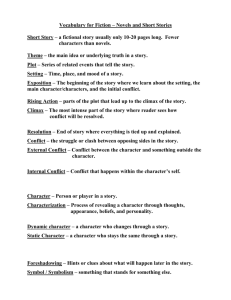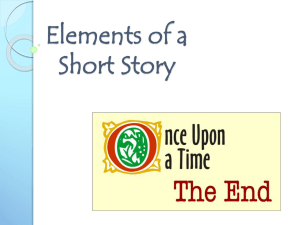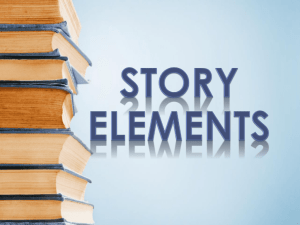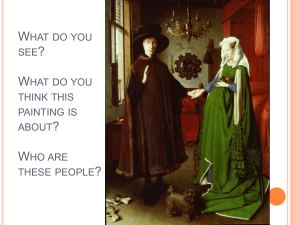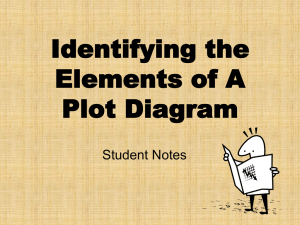Element of Plot - RHS Encore Academy
advertisement
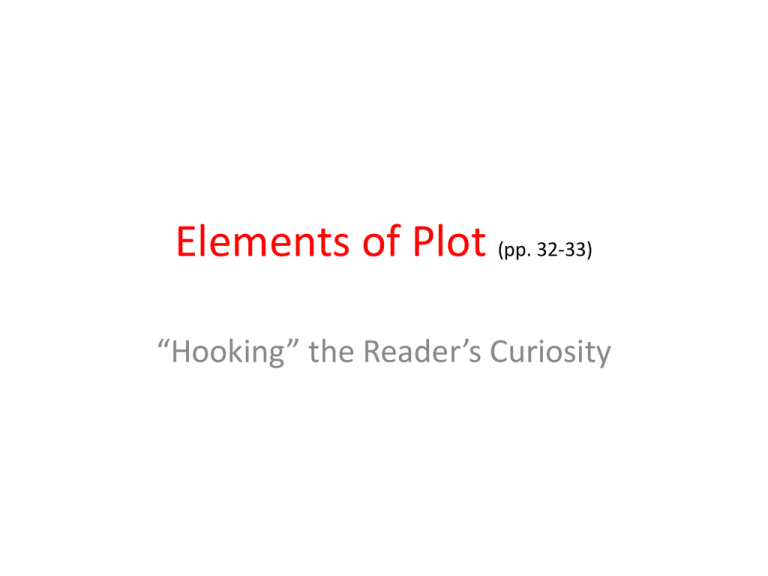
Elements of Plot (pp. 32-33) “Hooking” the Reader’s Curiosity I. PLOT • A series of related events, each event connected to the next, like links in a chain. PLOT • Each event in a plot “hooks” our curiosity and pulls us forward to the next event to satisfy that curiosity. When “story” hooks our curiosity • Monster hook . . . • The monster, preparing to paralyze his latest challenger, looked at his victim . . . •. . . and saw he was chewing gum. PLOT • Right away, we wonder what’s going to happen. Why isn’t the victim afraid, the way she should be??? • The dragon withdrew his venomous talons and asked the young person if he was laughing at him. • Why? the reader wonders. • Is the monster especially funny looking? • Is he very insecure? • Monster? PLOT • If our curiosity is aroused by these events, we wait for successive ones with mounting suspense. • We want to know: •“What happens next?” PLOT • This build up of suspense is how plot works. • A series of related events plants the hook of curiosity in us, making us read to find out: •What happens next? II. Conflict • We care about what happens next in a story because we’re hooked by a conflict, or struggle. A. External Conflict • External Conflict – • When the conflict takes place between a character and another person or between a character and something nonhuman. Man vs. Man • Man vs. Man • The struggle might take place between two characters Man vs. Society • Man vs. Society • The struggle might take place between a character and a whole group of people Man vs. Nature • Man vs. Nature – The struggle might take place between a character and something nonhuman - - a typhoon or a shark or gas in the mine pit or a computer virus. B. Internal Conflict • Internal Conflict • When the conflict takes place inside a character’s mind or heart. Conflict: Man vs. Self • Man vs. Self • The struggle can also take place within a character’s own mind and heart. Man vs. Self • The desire to be peaceable might conflict with an urge to knock the stuffing out of a bully Man vs. Self • A desire to win someone’s friendship might conflict with a fear of rejection Conflict • The MAIN CONFLICT of the story “drives” the story to its CLIMAX. The most intense and/or emotional moment of the story. • The CLIMAX concludes (ends) the MAIN CONFLICT. • Throughout the RISING ACTION of the story, there are many “complications” - - which can also be classified as Man vs. Man, Man vs. Society, Man vs. Nature, and Man vs. Self Story • Stories, like houses and human beings, need a structure or framework to hold them together. • Plots are usually built on four major parts, which make the “frame” of the story. III. Bare Bones of Plot A. Exposition • Exposition is the basic situation of the story. • This is the opening of the story where –the setting –the characters –their conflict . . . are introduced Cinderella - Exposition • Once upon a time there lived a young girl named Cinderella, who was as beautiful as she was good. But she was totally detested by her evil step-mother and two nasty and jealous stepsisters. Cinderella longed to go to the prince’s ball - - but it was simply out of the question. After all, Cinderella was just a kitchen servant. Exposition • Just a servant girl B. Rising Action - Complications • Complication • . . . is when the main character takes some action to resolve the conflict and meets with more problems • such as danger, hostility, fear, or even a new threatening situation. • The rising action of the story. • (Keeps readers interested!) Cinderella - Complications • A fairy godmother promised to get Cinderella to the ball if she obeyed one rule: “Be home by midnight.” Dressed in the most beautiful gown and wearing tiny glass slippers manufactured on the spot by her fairy godmother, Cinderella went to the ball. No one knew who this dazzling beauty was. The prince fell in love with her at first sight, but she had to flee at midnight. One of the dainty glass slippers was left behind as she ran out of the palace. Complications • “Be home by midnight.” C. Climax • Climax • . . . is the key scene of the story • - - that tense or exciting or terrifying moment when our emotional involvement is greatest. • Now we find out what the outcome of the conflict is going to be. Cinderella - Climax • The prince made a house-tohouse search for the foot that fit the tiny shoe. The stepsisters shaved off parts of their big feet to try to squeeze into the slipper, but no luck. The prince found that small foot on Cinderella. Climax • House-to-house search for a girl whose foot will fit in the small glass slipper D. Resolution (Denouement) • The final part of the story. • The resolution occurs at the end of the story (may only be one paragraph!) • Now all the struggles are over and we know what is going to happen to the people in the story. • The resolution “closes” the story. Cinderella - Resolution • Cinderella married the prince and they lived happily ever after. The stepsisters and the cruel stepmother, however, suffered ghastly punishments for their misdeeds. Cinderella - Resolution Exposition, Complication (the Rising Action), Climax and Resolution . . . • These 4 “bare bones” support a series of events intended to hook our curiosity. • If one of these elements of plot is weak, the story falls apart. The End
